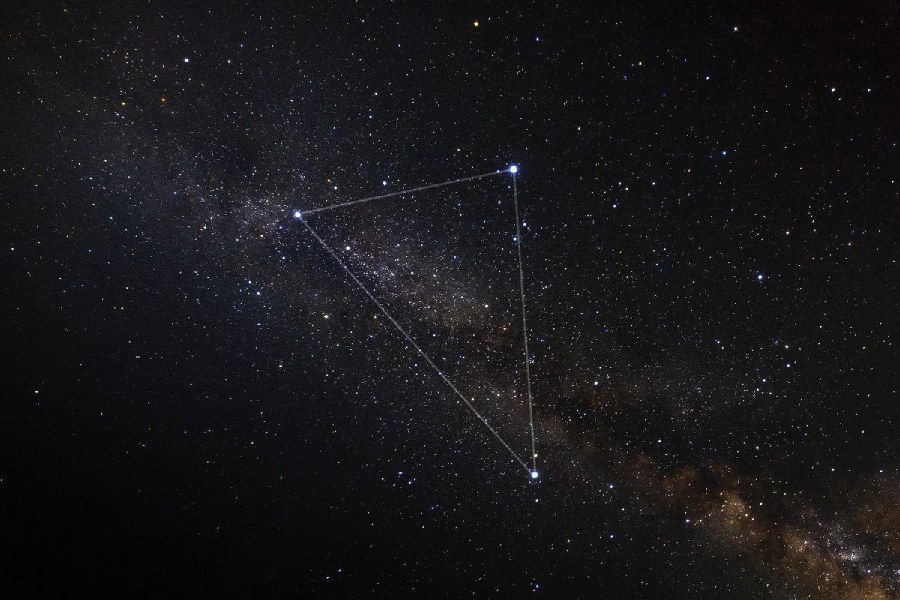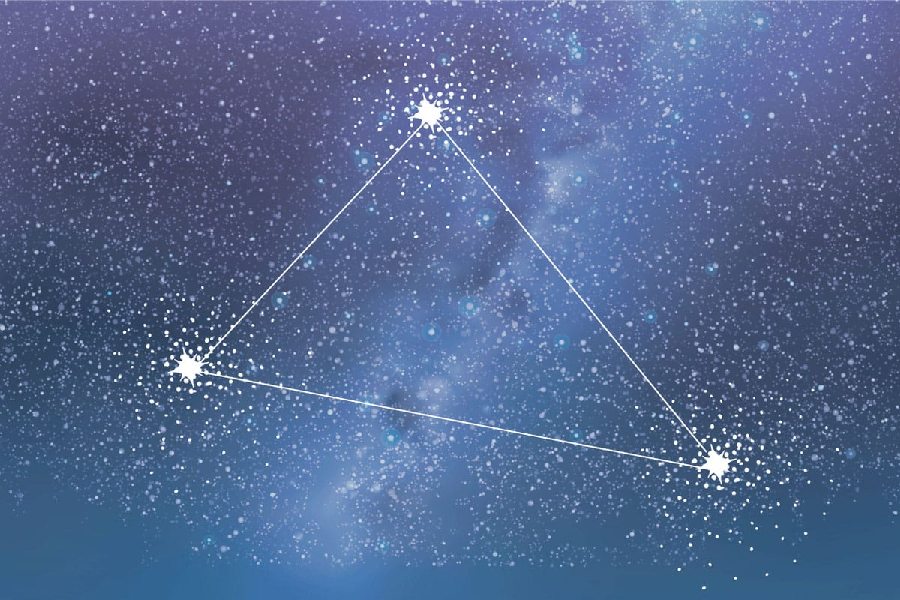As the warm nights of summer unfold, stargazers are treated to a celestial marvel that has captivated skywatchers for centuries. The Summer Triangle, a prominent asterism visible from mid-northern latitudes, graces the night sky with its breathtaking presence.
Composed of three brilliant stars from different constellations, the Summer Triangle serves as a celestial signpost, guiding the eye through the summer sky’s enchanting tapestry. Each star has its own unique story to tell, steeped in ancient mythology and astronomical significance.
In this article, we will embark on a fascinating journey to uncover the secrets of the Summer Triangle asterism. We’ll explore the rich history and folklore surrounding its stars, delving into the tales woven by civilizations long ago.
Moreover, we’ll venture beyond the naked eye and unveil the celestial treasures hidden within the triangle’s boundaries, accessible through backyard telescopes. Along the way, we’ll provide practical tips for locating and appreciating this celestial masterpiece, ensuring your stargazing experience is both rewarding and memorable.

What Defines the Summer Triangle Asterism?
What is the Summer Triangle asterism? The Summer Triangle is a prominent asterism visible in the northern hemisphere during summer, comprising three bright stars: Vega in Lyra, Deneb in Cygnus, and Altair in Aquila. Its distinct shape forms a triangle, making it easily recognizable in the night sky.
Astronomers and sky watchers often use the Summer Triangle as a guidepost. It helps them locate other celestial objects and constellations. Its brilliance and visibility during warm summer nights make it a popular feature admired by stargazers and enthusiasts alike.
History of the Summer Triangle
The Summer Triangle has mesmerized stargazers across ancient civilizations, with each civilization associating mythological tales with its stars. Greek legends depicted Vega as Orpheus’ lyre, Altair as Zeus’ eagle, and Deneb as the celestial swan Cygnus.
The asterism also held significance for Native Americans, Chinese astronomers, and Polynesian voyagers. Within this celestial beacon lie treasures, including the Ring Nebula, globular clusters, the North America Nebula, and the vibrant Milky Way’s galactic disk.
Other gems include the contrasting Albireo double star, the Dumbbell planetary nebula, and the Veil supernova remnant. Easily located in northern summer skies, the Triangle offers rewarding views through binoculars and telescopes on clear, dark nights. Astrophotography captures its splendor, while apps and charts guide exploration.
Discovery and Recognition
The discovery of the Summer Triangle is lost to antiquity; however, ancient cultures like the Babylonians likely first observed its prominence and associated it with cosmic significance. The modern name emerged in the 20th century.
For millennia, the Summer Triangle held cultural importance worldwide in myths, navigation, and timekeeping. Astronomically, its three bright stars are Vega, Altair, and Deneb. Vega is a nearby, brilliant main-sequence star. Altair is another rapidly spinning main-sequence star once astrologically revered. Deneb is a distant, luminous supergiant marking Cygnus’ tail.
As astronomy progressed, the region revealed insights into stellar distances and evolution, contributing to the mapping of the Milky Way’s structure.
Vega, Deneb, and Altair – The Stars Forming the Summer Triangle
Vega – The brilliant beacon
Vega reigns supreme as the brightest star in the Summer Triangle. Its dazzling blue-white glow makes it a captivating sight. Unlike Deneb, Vega is a close neighbor, residing only 25 light-years away. Remarkably similar to our Sun, it’s a stable main-sequence star.
Due to its prominence, Vega has served as a navigational guide for countless generations. It also holds a place in scientific history – being one of the first stars analyzed for its composition, revealing secrets about stellar makeup.
Deneb – The distant giant
While Deneb may appear the faintest among the Summer Triangle stars, it’s important to remember that it’s still visible to the naked eye, a feat in itself. Unlike the other two, Deneb is a true giant – a supergiant star.
Clocking in at over 1,400 light-years away, its immense distance is dwarfed by its staggering luminosity. Deneb outshines our Sun by nearly 200,000 times! This incredible brilliance is a hallmark of its nearing end-of-life stage.
Altair – The swift spinner
Altair, residing in the Aquila constellation, boasts a different kind of distinction. It’s a rapidly rotating main-sequence star, its spin so fast it bulges slightly at the equator, appearing oblate.
Slightly hotter than our Sun, Altair sits at a comfortable distance of 17 light-years. This swift star also holds historical significance. Its name, originating from Arabic, translates to “the flying one”. Altair played a role in ancient astrological traditions, associated with good luck and fortune.

Constellations Hosting the Summer Triangle
Lyra and Cygnus constellations
Vega is the brightest star in the Lyra constellation, which represents a lyre or small harp in Greek mythology. Lyra is one of the smallest constellations in the sky, with other notable stars, including Sheliak and Sulafat. In Greek tales, Lyra was the instrument of Orpheus. He used its entrancing music to charm all living things. After his death, the lyre was sent into the heavens, honoring Orpheus’ musical legacy.
Deneb marks the tail of the majestic Cygnus constellation, depicting a flying swan in Greek myths. Cygnus is one of the most recognizable northern constellations, with other bright stars like Albireo and Sadr.
Greek stories tell of Zeus transforming into a swan, with Cygnus representing either the god himself or one of his lovers. The constellation was important for celestial navigation, as its cross shape helped to find the north celestial pole.
The Summer Triangle is not a constellation itself but an asterism formed by the brightest stars of three different constellations: Lyra, Cygnus, and Aquila. So, if you’re wondering what constellation is the Summer Triangle in, the answer is that it spans across these three constellations.
Aquila constellation
Altair is the brightest star in the Aquila constellation, representing the eagle carrying Zeus’ thunderbolts. Aquila is a relatively small but striking constellation with other bright stars, including Alshain and Tarazed.
In Greek lore, the eagle was Zeus’ faithful servant, guarding the god’s lightning bolts and scepter. The constellation symbolized strength and vigilance and was linked with good omens for ancient Babylonians.
Brightest Stars in the Asterism
Vega reigns supreme in the Summer Triangle, taking the crown as the fifth-brightest star we can see at night. Its dazzling brilliance, with an apparent magnitude of 0.03, stems from two key factors – its proximity (a mere 25 light-years away) and its intrinsic luminosity. Vega burns intensely across the light spectrum, amplifying its radiant blue-white glow.
Deneb, though appearing fainter, holds a surprising secret. It’s a true giant, a supergiant star, outshining our Sun by a staggering 200,000 times! Its immense distance dims its apparent brightness, but don’t be fooled. Deneb boasts an absolute magnitude of -7.2, placing it among the most intrinsically luminous stars ever discovered. Its hidden brilliance is truly mind-boggling.
Altair slots in between Vega and Deneb in terms of brightness. While not quite as dazzling as Vega, it still packs a punch with an apparent magnitude of 0.77. Interestingly, Altair’s incredible rotational speed contributes to its luster. Spinning close to its theoretical limit, it concentrates its radiant energy, making it appear even brighter.
Distances Between the Stars
Altair is moderately distant at 17 light-years, farther than Vega but much closer than Deneb. Its brightness stems from luminosity and rapid spin. Despite being nearer, calculating Altair’s precise cosmic address was challenging initially.
Deneb is immensely distant. It’s over 1,400 light-years away, making it one of the most remote bright stars visible. This vast gulf diminishes its brilliance; only inherent luminosity keeps it visible.
Measuring Deneb’s removal proved difficult, as parallax failed at such scales. Spectroscopic parallax offered better estimates. It showcased the universe’s enormity through Deneb’s remoteness. The stars’ varying distances highlight astronomy’s challenges in cosmic cartography.
Diversity of Stars Within the Asterism
The Summer Triangle asterism showcases remarkable stellar diversity. Vega is a hot, bluish-white main sequence star. Altair burns hotter. Deneb is a cool, reddish supergiant nearing the end of its life. Vega and Altair are comparable in size to our Sun. However, Deneb is enormously bloated, over 200 times larger than Vega and Altair, which are comparable in size to our Sun.
Their rotation rates also differ – Vega spins moderately, while Altair is one of the most rapid rotators known, appearing oblate. Deneb’s rotation is undetermined due to its turbulent surface.
This trio therefore exemplifies the rich diversity found among stars, encapsulating the awe-inspiring range of stellar properties within a single celestial pattern.
Conclusion
The Summer Triangle asterism stands as a celestial masterpiece. It captivates skywatchers with its brilliance and unique arrangement of stars. Through exploring its defining features and historical significance, we’ve unraveled its rich tapestry. We’ve also dived into the stars within its bounds.
From ancient civilizations to modern-day astronomers, the Summer Triangle continues to inspire awe and spark curiosity. We hope this journey has illuminated the beauty and intricacy of the night sky. It invites you to gaze upward with newfound appreciation.
Whether tracing its history or marveling at its luminous stars, the Summer Triangle asterism serves as a timeless reminder of the vastness and wonder of our universe. Let it guide your celestial explorations and spark a lifelong fascination with the cosmos.
